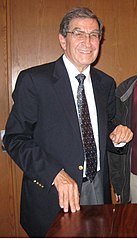Malcolm Bilson
 | |
| Data i miejsce urodzenia | |
|---|---|
| Pochodzenie | amerykańskie |
| Instrumenty | |
| Zawód | |

Malcolm Bilson (ur. 24 października 1935 w Los Angeles[1]) – amerykański pianista specjalizujący się w wykonaniach na instrumentach historycznych. Wykładowca w Cornell University w Nowym Jorku.
Bilson zasłynął serią nagrań koncertów fortepianowych Wolfganga Amadeusa Mozarta z towarzyszeniem sir Johna Eliota Gardinera i orkiestry English Baroque Soloists. Zarejestrował komplet sonat fortepianowych Mozarta, Schuberta oraz – we współpracy z szóstką swoich absolwentów – Beethovena. Nagrał także DVD "Knowing the Score", w którym podważa szereg podstawowych koncepcji wykonawczych, według których uczy się w konserwatoriach i szkołach muzycznych na całym świecie (m.in. odnośnie do artykulacji oraz rytmu w dawnych utworach).
Uczestniczy w pracach jury Międzynarodowego Konkursu Bachowskiego w Lipsku.
Przypisy
- ↑ Malcolm Bilson w bazie AllMusic (ang.)
Linki zewnętrzne
Media użyte na tej stronie
Autor: Innerkip (talk), Licencja: CC BY-SA 3.0
Picture of Malcolm Bilson at a masterclass at the University of Michigan, Ann Arbor, in 2009.
Autor: Shriram Rajagopalan, Licencja: CC BY 2.0
Pianoforte (Florence, 1720) by Bartolomeo Cristofori (1655-1731)
- "An early (1700s I think) model of a piano. Only 4 pianos of this type were made."
Grand Piano - Bartolomeo Cristofori Date: 1720 Geography: Florence, Italy Medium: Various materials Dimensions: Case length (perpendicular to keyboard) 228.6 cm, Width (parallel to keyboard) 95.6 cm, Case depth without lid 23.5 cm, Total height 86.5 cm, 3-octave span 49.6 cm, L. of longest string 188.6 cm, L. of shortest string 12.0 cm, L. of c2 27.9 cm Classification: Chordophone-Zither Credit Line: The Crosby Brown Collection of Musical Instruments, 1889 Accession Number: 89.4.1219 Description:
Bartolomeo Cristofori was the first person to create a successful hammer-action keyboard instrument and, accordingly, deserves to be credited as the inventor of the piano. This example is the oldest of the three extant pianos by Cristofori. About 1700 he began to work on an instrument on which the player could achieve changes in loudness solely by changing the force with which the keys were struck. By 1700 he had made at least one successful instrument, which he called "gravicembalo col piano e forte" (harpsichord with soft and loud). His instrument still generally resembles a harpsichord, though its case is thicker and the quill mechanism has been replaced by a hammer mechanism. Cristofori's hammer mechanism is so well designed and made that no other of comparable sensitivity and reliability was devised for another seventy-five years. In fact, the highly complex action of the modern piano may be traced directly to his original conception.

